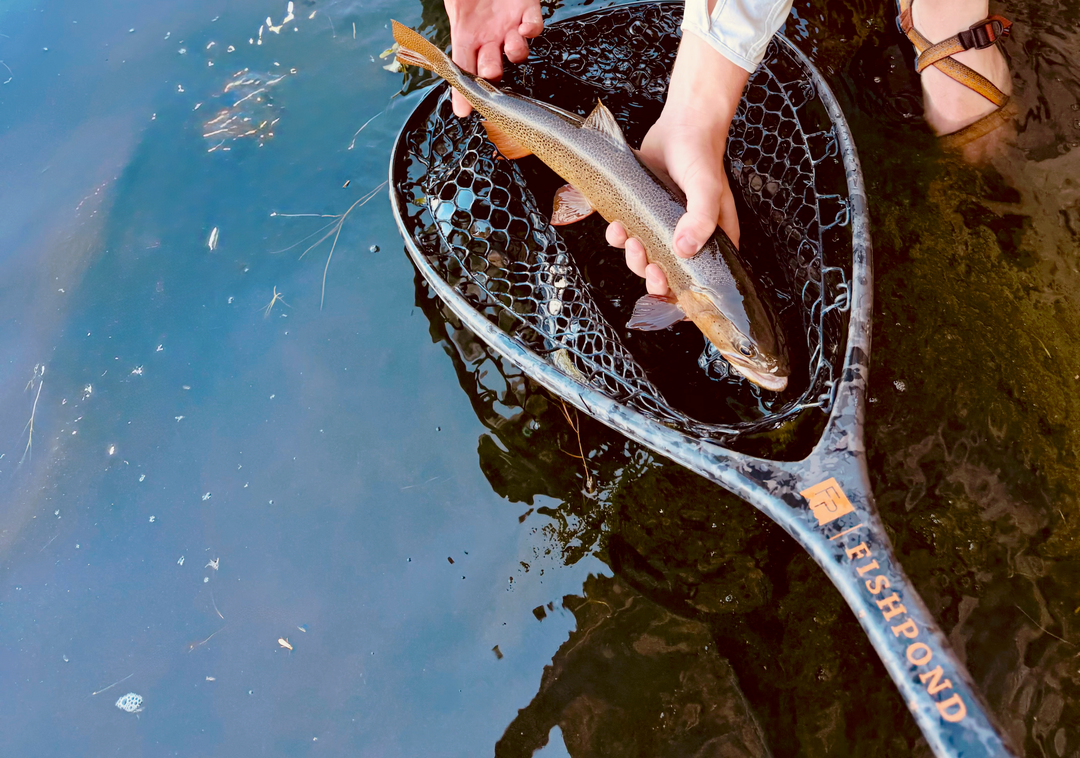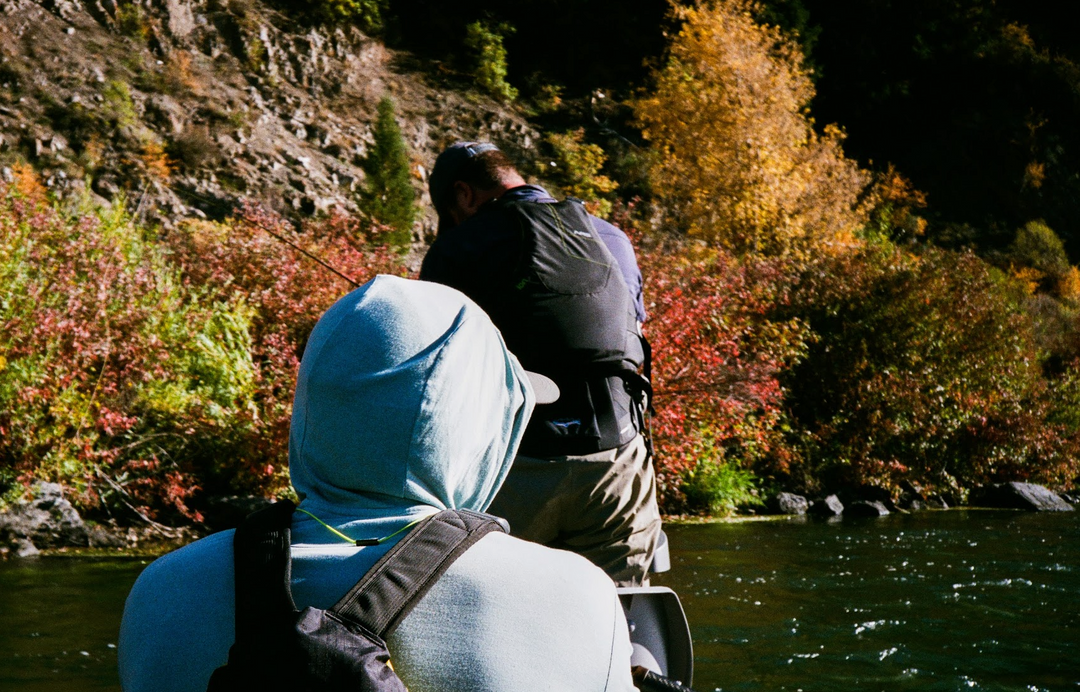Accuracy vs Precision in Fly Fishing
You might be thinking, “Aren’t accuracy and precision just two words for the same thing?” Fair question—but nope, they’re definitely not the same. And in fly fishing, understanding the difference between the two can help you become a better angler by being a more effective caster.
Take a look at the graphic below. It’s a simple visual, but it helps illustrate the concept.

-
Precision measures how close measurements are to each other.
-
Accuracy measures how close a result is to the target (bullseye).
So accuracy is hitting the target and precision is hitting the same spot time and time again.
Why does this matter?
Let’s use hopper fishing as an example. It’s summer, the water’s lower and clear, and fish are on the lookout for big meals. Hoppers are perfect: they get blown in from grassy banks and bushes, and trout know exactly where to wait for them. The edge of the bank becomes prime feeding territory—not only because food falls in there, but also because the slower current along the bank makes it easier for fish to hold position.
So here’s the casting reality: if you can consistently place your fly 6 inches from the bank every single time, that’s great precision. But if the fish are eating at 2 inches and you’re missing that sweet spot, you’re not accurate. On the flip side, maybe you hit that 2-inch zone once every 15 casts—sure, that’s accuracy, but without repeatability, it’s not precision. You want both. You want to hit that prime zone time and time again - eventually you'll put enough successful casts in the right spot where larger fish are typically holding in a stream to rope in one of those big brown trout you see all over Instagram.
And it’s not just about dry fly fishing or hopper fishing either. Even indicator (bobber) fishing—something most people don’t associate with finesse—has its own accuracy/precision demands. A big, heavy nymph rig is awkward to cast. It doesn’t behave like a dry fly or even a streamer. If you’re in a boat and trying to get a drag-free drift, your cast needs to land that rig upstream of the target, with the right angle and distance so that your flies sink and arrive at the strike zone naturally - they might be at the right depth but if the fish are eating a foot to the left or right that still isn't accurate.
Now that we understand the differences between these two we’ll break down a couple factors that can impact our accuracy/precision on the water:
-
The physics behind fly casting—how energy loads into the rod, travels through the fly line, and sends that fly to your target.
-
What impacts both accuracy and precision in your casting, including gear choices, line control, and mother nature.
In subsequent articles we'll talk about specific casting drills and how we can improving our casting can make us better anglers quickly.
The Physics of a Fly Rod: Learn What’s Happening

Before we dive into what can hurt your accuracy and precision, let's begin with how a fly rod actually casts. As dorky as it may sound, mastering the basic physics of the fly cast is essential for improvement. If you and your friends don’t get the why behind the cast, and lack accurate knowledge about casting mechanics, then your attempts at tightening things up are always going to feel like guesswork. Think of this as building the foundation—you can’t fine-tune your shot if you don’t know how the bow works.
How Does Fly Casting Work?
Fly casting isn’t about power. It’s about timing, tempo, and energy transfer. Unlike spin or baitcasting—where the weight of the lure essentially pulls the line out—fly fishing flips that dynamic on its head. You’re casting a nearly weightless fly, and relying on a weighted fly line to do the heavy lifting. The weight of the fly line carries the fly through the air, allowing for accurate and long-distance casting. As you cast, the fly line forms loops that unfurl and extend smoothly toward your target. That means the entire system—the rod, the line, your casting stroke—has to work together seamlessly.
What Actually Makes the Fly Go? Power?
The "secret" is impulse. When you cast, you’re accelerating the fly rod, then stopping it abruptly. That stop transfers energy from the flexed rod into the fly line, which unrolls in a loop and carries the fly to your target. It’s not about muscle—if anything, brute force works against you (something beginners tend to do). With proper technique, effective casting requires surprisingly little effort; a smooth, controlled acceleration followed by a crisp stop is what loads the rod and generates that tight, snappy loop we all want.
Here’s what’s going on under the hood:
-
Impulse Transfer: You’re building momentum during the cast, and when the rod stops, that energy gets pushed through the line and launches the fly forward.
-
Rod Tip Path: If your rod tip moves in a straight line, the loop will be tight and efficient. If your tip arcs or dips, you’ll get wide loops, tailing loops, or just sloppy energy transfer.
-
Backcast + Forward Cast: Both are equally important. On the backcast, you’re loading the rod by storing energy. On the forward cast, you’re releasing that energy—and both require a clean stop. Without that pause at the end of each stroke, the rod can’t unload properly.
When casting goes wrong—when loops collapse, lines pile up, or flies don’t go where they’re supposed to—it’s usually because the caster didn’t let the system time do its job. Either they rushed it, used too much force, or never got the rod tip tracking straight.
So before we start talking about what can affect our accuracy and precision in specific fishing scenarios, you’ve got to have a basic understanding of this physics-driven movement. The cast isn’t just a flick of the wrist. It’s a deliberate, timed transfer of energy that, when done well, feels almost effortless.
Mastering this is the first real step toward becoming both accurate and precise. Once you understand how the cast works, you can start to control it—and once you can control it, you can start putting flies exactly where you want them, as many times as you need to.
Next up: what impacts your ability to actually cast accurately and with precision in the real world.
What Can Challenge Your Presentation?

Once you understand how fly casting works, the next step is recognizing the factors that influence your ability to cast accurately and with precision. This isn't an all inclusive list of issues, but these are some of the larger core issues that can impact your ability to hit the mark.
How Rod Action Impacts Accuracy
Rod action—how much and where a fly rod flexes or bends during the cast—has a major influence on your casting timing, loop shape, and overall accuracy. In simple terms, different rod actions are better suited for different jobs. Choosing the right one based on your fishing style, target species, and conditions can dramatically improve both precision and consistency.
Medium-action rods are popular for trout fishing because they offer a good balance of finesse and control. But when it comes to saltwater fishing, most anglers use fast or extra-fast rods. That stiffer backbone makes it easier to generate high line speed, cut through wind, and deliver accurate casts at longer distances with fewer false casts. It’s not just preference—it’s about having the right tool for the job.
Slow-action rods, by contrast, flex deeper into the blank and are ideal for making soft, delicate presentations in calm water. While that’s great for spooky trout sipping dries in a spring creek, it’s not the rod you’d want for punching a streamer into a stiff headwind. The key takeaway: different rod actions perform differently, and matching your rod to the situation plays a big role in casting accuracy.
If you're interested in learning about rod action and the best rods for fishing from a boat give this article a read.
Line Weight: The Unsung Factor in Cast Performance
When it comes to dialing in your cast, one of the most overlooked factors is line weight—and we’re not just talking about the number printed on the box (5wt, 6wt, etc.). Fly lines are rated on a grain-weight scale, and there's actually some wiggle room within each designated line size. That means not all 5-weight lines are created equal, and that difference can significantly impact how your rod loads and how your cast performs.
A Line’s True Weight Can Vary
The industry standard for fly line weights is based on the grain weight of the first 30 feet of line. A 5-weight, for example, should weigh about 140 grains in that range—but manufacturers often build lines that are half a size to a full size heavier than the standard. This is especially common in “trout taper,” “power taper,” or “line for fast action rods” variations. Why? Because that extra weight helps load modern, stiffer rods more effectively with less effort—especially at short to medium distances.
How Extra Line Weight Can Improve Your Cast
-
Improved Rod Loading at Short Range
When fishing tight quarters or making quick casts (think: drift boat hopper fishing), a slightly overweighted line helps the rod load faster, which gives you more power and a tighter loop with less false casting. -
More Stable Loops in Windy Conditions
A heavier line carries more energy through the loop. That translates into better turnover and stability when casting into the wind—something a standard-weight line might struggle with on lighter rods. -
Easier Turnover of Heavier Rigs
If you're fishing nymphs under an indicator or throwing weighted streamers, that extra grain weight can help turn over your rig more effectively, leading to better accuracy and fewer collapsed casts. -
Forgiveness for Imperfect Timing
Slightly overweighted lines are also more forgiving if your casting timing isn’t perfect. That can be a huge help for newer anglers still developing their cast or anyone transitioning to faster-action rods.
A Note of Caution
While a heavier line can improve loading and turnover, it’s not a fix-all. If your rod is already very soft or if you’re fishing delicate dry flies on flat water, too much line weight can easily overpower the rod and lead to splashy, uncontrolled presentations. This is where knowing your gear—and matching your line to your rod and style—really pays off.
Match the Line to the Job
Just like choosing the right rod action or leader length, fly line weight should match the conditions you’re fishing and the performance you want. Don’t be afraid to test a line that’s a half-weight or even a full-weight heavier than what’s printed on your rod. You might find that extra mass gives you a more responsive feel and better results, especially when chasing accuracy and precision under real-world conditions.
One of my rods fishes really well with a SA MPX Fly Line (210g head) and doesn't feel anywhere near as good when I've fished with a Rio Gold (168g head). It's a long rod and feels completely different with two lines that are both WF6F size. So if a rod doesn't feel great - try a different line! The line plays a much more important role than most anglers are aware of.
Wind: Your Invisible Opponent
Wind doesn’t just throw your fly off target—it forces you to rethink your approach. Crosswinds can wreck loop shape, and tailwinds require higher backcasts to keep your line from slapping the water behind you. A tight loop created by a fast-action rod and a crisp casting stroke helps punch through headwinds and stabilize your presentation. Wind is one of those real-world variables that highlights just how different casting in a backyard is from casting on a river. If you're next trip involves fishing in the middle of a river in Wyoming in 50mph winds it would do you a service for that super light dry fly rod to remain at home and bring the bigger rods out to play.
Distance: More Line, More Problems
The farther you cast, the harder it becomes to maintain both accuracy and precision. Why? Because tiny errors in loop formation or rod tip path are magnified the more line you have out. Longer casts also exaggerate the effect of wind, slack line, and poor timing. Practice at multiple distances, not just long bomb hero shots, so you can confidently hit targets at 20, 40, and 60 feet with control. Pay attention to the number of casts you make during practice to, as minimizing unnecessary casts can improve casting efficiency and presentation.
Also it makes it a lot harder to set the hook when you're 60' away compared to 30' so even if you can be accurate at that distance that doesn't mean you'll actually be able to hook and then net the fish.
Reading Water: How River Conditions Influence Your Cast
If you want to improve your casting and catch more fish, learning to read water is absolutely essential. Rivers are constantly changing—flow, depth, and current speed all affect how your fly should be presented. A good cast in one condition might be the wrong move just a few yards away. That’s why understanding water dynamics is so important: it helps you choose the right cast, the right gear, and the right approach to get your fly where it needs to be.
Before you make your first cast, take a moment to observe. Look for changes in current speed, subtle shifts in depth, and the structure of seams and eddies. These clues will tell you where fish are likely to be holding, where your fly needs to land, and how fast your fly will need to move to look natural. In fast water, for example, you'll need quick, decisive casts—using heavier flies or shorter leaders to cut through the current and stay in the strike zone long enough for fish to react. In slow water, the fish have more time to inspect your presentation, so accuracy and a delicate presentation and drift become even more important.
The key is to match your casting style and rig to the water in front of you. Subtle adjustments—like changing where you stand or how you angle your rod—can turn a missed opportunity into a perfect drift. The more time you spend reading water and adapting your approach, the more instinctive and effective your casting will become.
Become Effective With Each Cast - Practice

At the end of the day, accuracy and precision in fly fishing aren’t just abstract concepts or general principles—they’re real-world skills that directly impact how many fish you catch.
Accuracy means your fly lands at the point where the fish are feeding. Precision means you can do it over and over again, cast after cast. You need both. A perfect shot once in a while might get you a grab, but it’s the angler who can repeatedly hit the zone—tight to the bank, behind the rock, in the drift lane—who consistently finds success.
Whether you’re picking apart pocket water on foot or firing quick shots from the front of a moving boat, developing both accuracy and precision will elevate your game. And it starts with understanding how a cast works, how rod and line choices affect performance, and how to practice intentionally—not just flinging line around, but actually aiming with purpose.
So next time you’re on the water, ask yourself: Am I hitting the mark? Can I do it again? If the answer isn’t a confident yes, you’ve got your next challenge. Master this, and you won’t just be casting better—you’ll be fishing better.
In our next post we’ll go through some casting practice drills that can help improve your angling.




